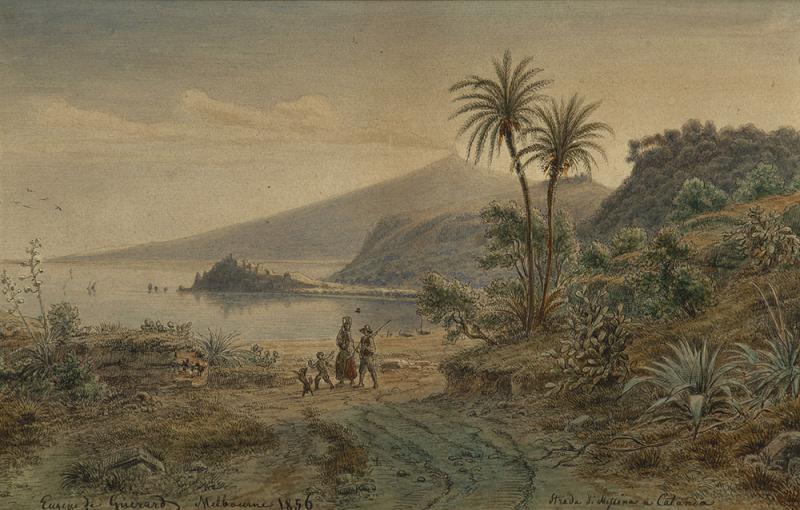EUGENE VON GUERARD (1811-1901)
Strada di Messina a Catania 1856
Estimate: $25000 - 35000
Sold For:
$30000 hammer
Description
EUGENE VON GUERARD (1811-1901)
Strada di Messina a Catania 1856
ink and watercolour on paper
15.5 x 25.0 cm
signed, dated and inscribed lower left: Eugene de Guerard, Melbourne, 1856
inscribed lower right: Strada di Messina a Catania
Provenance:
Queensland Fine Art Auctions, Brisbane, 3 December 1989, lot 227 (as Strada Di Meflona a Catania)
Christie's, Australian Pictures and Sculpture, Melbourne, 11 April 1990, lot 155
Private collection, Sydney
Menzies, Melbourne, 14 September 2011, lot 75
Private collection, Melbourne
Estimate: $25000 - 35000
Result Hammer: $30000
As the son of Bernard von Guérard, miniaturist and court painter to Emperor Franz Joseph I of Austria, Eugene von Guérard was immersed in art from a tender age. His father’s influence is evident in his disciplined practice of undertaking rigorous studies in pocket-sized leather bound notebooks and his meticulously detailed works on paper and canvas.
Von Guérard was introduced to Italy when he moved with his father to live in Rome from 1830 to 1832. Here he studied under Giovanni Battista Bassi (1784-1852) who adhered to the legacy of leading seventeenth-century landscape artists such as Salvator Rosa (1615-1673), Claude Lorrain (c.1600-1682) and Nicholas Poussin (1594-1665). Significantly, Bassi encouraged his students to pursue ‘truth’ in landscape painting. Von Guérard also mixed with some expatriate German painters, later known as the Nazarenes, who rejected neoclassicism and instead adhered to pursuing honesty in art.
In 1841, von Guérard enrolled at the Düsseldorf Academy. Under the directorship of Wilhelm von Schadow (1789-1862), and lecturer Johann Wilhelm Schirmer (1807-1863) the academy was one of the leading art schools in Europe and promoted the study of elevated subject matter in the search for greater truthful realism in art. While von Guérard’s style at this stage was influenced by the German Romantic school, exemplified by Caspar David Friedrich (1774-1840), it was also clearly informed by the work of renowned scientist Alexander von Humboldt (1769-1859) who advocated artists use precision in their portrayal of the landscape.
On August 17th, 1852, von Guérard sailed aboard the Windermere to Australia, arriving in Port Phillip Bay in December 1852. After a stint on the Ballarat goldfields, he quickly returned to art. Soon he was recognised as the leading artist in the colonies, best known for his landscapes and homestead portraiture. In the thirty years before his departure from Australia in 1882, there were some works completed with European subject matter, however these are rare. While his motivations for undertaking Strada di Messina a Catania are unclear, it is possible this work served to ease a longing to return to Italy, some twenty years after he had lived there. Alternatively it is feasible the work was a gift, like another Italian landscape, Tempio d’Apollo et Lago d’Averno, 1859, which was given by the artist to his friend and art critic ‘the illustrious Mr. James Smith by his most faithful and sincere friend Johann Eugen von Guérard’.1
Strada di Messina a Catania is a wonderful example of von Guérard’s mastery of techniques and influences gleaned early in his career. It is a delightful scene with tenderly rendered figures accompanied by a dog. The group is almost certainly heading north from Catania to Messina along the east coast of Sicily. Mount Etna is in the distance billowing volcanic plumes. The scene is framed by palms and other plants so detailed as to be botanically identifiable. A contemporary critique of another landscape by von Guérard could just as easily be applied to Strada di Messina a Catania, where the artist ‘succeeded in expressing the character of the scenery… the very details of foliage are given with a microscopic minuteness… every landscape is an accurate portrait of the scene it professes to portray; every tree and flower has not merely its local character, but its botanical peculiarities; and yet the whole is a picture in the fullest sense of the word, and a fine picture too.’2
Footnotes
1. Bruce, C., Comstock, E., and McDonald, F., Eugene von Guerard: A German Romantic in the Landscape in the Antipodes, Alister Taylor Publishers, Martinborough New Zealand, 1982, p.204.
2. Illustrated Journal of Australasia, Volume IV, January-June 1858, p.35-36, ,cited ibid, p.199.
Marina Brennan, BA (Hons)
Location
SYDNEY VIEWING. 6 - 9 March 11am - 6pm. 12 Todman Avenue, Kensington
MELBOURNE VIEWING. 13 - 19 March 11am - 6pm. Stonington Mansion, 336 Glenferrie Rd, Malvern
